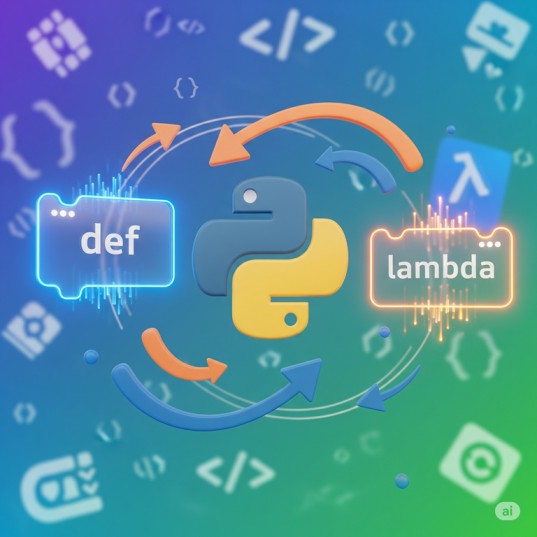Have you ever cooked the same recipe again and again? Wouldn’t it be easier if you had a ready-made recipe card so you don’t have to remember every step each time?
That’s exactly what functions in Python do!
They help you write code once and reuse it anywhere in your program.

What is a Function?
A function is a block of code that performs a specific task.
👉 Instead of writing the same code again and again, you can put it inside a function and call it whenever needed.
How to Create a Function in Python?
We use the def keyword to define a function.
Syntax:
def function_name(parameters):
# code block
return resultdef→ keyword to define functionfunction_name→ name of your functionparameters→ input values (optional)return→ gives back a result (optional)
Example 1: A simple function
def greet():
print("Hello, welcome to Python!")
greet() # calling the functionOutput:
Hello, welcome to Python!
Example 2: Function with parameters
def greet_user(name):
print(f"Hello {name}, nice to meet you!")
greet_user("Tejas")
greet_user("Riya")Output:
Hello Tejas, nice to meet you!
Hello Riya, nice to meet you!
Example 3: Function with return value
def add(a, b):
return a + b
result = add(5, 7)
print("Sum is:", result)
Output:
Sum is: 12
Example 4: Default parameters
def greet_user(name="Guest"):
print(f"Hello {name}, welcome!")
greet_user("Aman")
greet_user()
Output:
Hello Aman, welcome!
Hello Guest, welcome!
Example 5: Functions with multiple return values
def calculate(a, b):
return a + b, a - b, a * b
x, y, z = calculate(10, 5)
print("Addition:", x)
print("Subtraction:", y)
print("Multiplication:", z)
Output:
Addition: 15
Subtraction: 5
Multiplication: 50
Also Read: Loops in Python
Lambda Functions in Python (Anonymous Functions)
Sometimes you don’t need a big function with a name.
You just want a small, quick function for one-time use.
For that, Python gives us lambda functions.
Syntax:
lambda arguments: expression
lambda→ keywordarguments→ input valuesexpression→ single line of code (result is returned automatically)
Example 1: Square of a number
square = lambda x: x * x
print(square(6))Output:
36
Example 2: Add two numbers
add = lambda a, b: a + b
print(add(10, 20))Output:
30
Example 3: With map()
Suppose we want to square every number in a list. Instead of writing a full function, we can use lambda inside map()
numbers = [1, 2, 3, 4, 5]
squares = list(map(lambda x: x**2, numbers))
print(squares)Output:
[1, 4, 9, 16, 25]
Example 4: With filter()
If we want only even numbers from a list:
numbers = [10, 15, 20, 25, 30]
evens = list(filter(lambda x: x % 2 == 0, numbers))
print(evens)Output:
[10, 20, 30]
Example 5: With sorted()
We can sort a list of tuples by the second value using lambda:
students = [("Riya", 21), ("Aman", 19), ("Tejas", 22)]
sorted_students = sorted(students, key=lambda x: x[1]) # x[0] = 'name', x[1] = 'age'
print(sorted_students)Output:
[('Aman', 19), ('Riya', 21), ('Tejas', 22)]
Key Takeaways
- Functions help you organize code and reuse it.
- Use
defwhen you need a named, reusable function. - Use
lambdawhen you need a quick one-line function. - Commonly used with map(), filter(), reduce(), and sorted().
Mini Project Challenge
Write a function-based program for a Student Grading System:
- Ask user to enter marks of 3 subjects
- Create a function that calculates the average
- Another function should decide the grade (A, B, C, Fail)
- Print result
👉 Sample Output:
Enter marks of 3 subjects: 75 80 90
Average Marks = 81.67
Grade = AFinal Thoughts
Functions are the building blocks of Python programming.
They not only save time but also make your programs more professional and clean.
FAQs – Functions in Python
Why should we use functions?
Functions make code cleaner, reusable, and easier to understand. They help you avoid repetition and improve debugging and testing.
What is the difference between built-in functions and user-defined functions?
Built-in functions are already available in Python (like
print(),len(),type()).User-defined functions are functions you create using the
defkeyword.
Can a function return multiple values?
Yes ✅, Python allows returning multiple values as a tuple. For example:
Calling calc(5, 3) will return (8, 2).
What is a lambda function?
A lambda function is a short, anonymous function created using the lambda keyword. Example:
They are often used when you need a simple one-line function.
Can we call a function inside another function?
Yes, this is called function nesting. One function can call another to complete a task.
What’s Next?
In the next post, we’ll learn about the Lists in Python